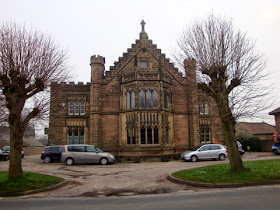Ripley
Although it has a castle, a town hall and a market place, Ripley is not a town, it is a small estate village close to the River Nidd.
This estate
has belonged to the Ingilby family since the 14th century. Thomas
Ingilby (1290-1369), who descended from
a noble line dating back to the Norman Conquest, held high office in the
judiciary during the reign of King Edward 111. In 1355, while hunting wild boar
with the King in the Forest of Knaresborough, Ingilby prevented the King from
suffering serious injury or even death by killing a wounded boar that was about
to attack the King. The King knighted him and granted him a Charter for a
weekly market and annual fair at Ripley. Sir Thomas adopted a boar’s head into
his coat of arms.
There is an effigy of Sir Thomas on his tomb in the village church.
The Boar's Head doorknocker
This lovely village
was largely rebuilt in the 1820,s by Sir William Amcotts Ingilby who was
inspired by the architecture of a
village in Alsace-Lorraine in France and the fine village hall bears the
inscription ‘Hotel de Ville.’
 |
 |
A unique
curiosity can be seen in All Saints churchyard at Ripley, it is the base of a Weeping Cross and probably the only
such cross in the country. It is Grade 11 listed. The base is circular and has
eight niches spaced around it for kneeling or maybe for bowed heads. The origins
of such a cross are obscure but it seems to have been connected with penitents
and pilgrims and may date back to the 2nd century.
The village church of All Saints dates to c1400 and replaced a former church known as the Sinking Chapel which had become ruinous because of its proximity to the river. It contains the tombs of the Ingilby family.
The tomb of Sir William Ingilby (1546-1618), known as 'single bee', a pun on his surname. is inscribed :
"reader dissolve in tears, else blame thine eyes worth, honour, virtue here entombed lies; The bee which honey from each flower brought. Lives now eternally on what he wrought. A single bee, yet furnishing his hive with everlasting sweets; dead to survive".
The tomb was defiled by Cromwell's troops during the Civil War, who added :
"NO POMPE NOR PRIDE LET GOD BE HONORED."
Oliver Cromwell billeted his troops and stabled his horses
actually in the church at Ripley after the Civil War battle of Marston Moor in
1644. He had pursued the losing Royalist’s after the battle and reached Ripley
by nightfall. Several Royalist prisoners, Ripley men, were executed against the rear wall of
the church where bullet marks are still evident today.
Royalist, Sir William Ingilby of Ripley Castle had raised a
troop of horsemen from the Ripley district and had joined the King’s army in
the nearby battle of Marston Moor. Sir William was also accompanied by his sister who was known as
Trooper Jane and disguised as a man she wore a full suit of armour. The
Ingilby’s had managed to escape back to Ripley after the battle was lost and must have been most alarmed
when Cromwell arrived at their gate demanding admission. Jane quickly hid her
brother in a secret priest’s hideaway in the castle and then admitted Cromwell who
insisted on staying overnight in the castle. Jane granted his wish on the
understanding that she would remain armed with two pistols and Cromwell was
allowed to sleep in the castle library with Jane standing guard.























No comments:
Post a Comment